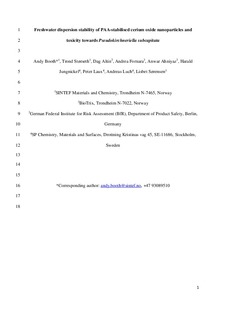| dc.contributor.author | Booth, Andy | |
| dc.contributor.author | Størseth, Trond Røvik | |
| dc.contributor.author | Altin, Dag | |
| dc.contributor.author | Fornara, Andrea | |
| dc.contributor.author | Ahniyaz, Anwar | |
| dc.contributor.author | Jungnickel, Harald | |
| dc.contributor.author | Laux, Peter | |
| dc.contributor.author | Luch, Andreas | |
| dc.contributor.author | Sørensen, Lisbet | |
| dc.date.accessioned | 2017-11-20T19:59:49Z | |
| dc.date.available | 2017-11-20T19:59:49Z | |
| dc.date.created | 2014-10-08T23:00:36Z | |
| dc.date.issued | 2015 | |
| dc.identifier.citation | Science of the Total Environment. 2015, 505 596-605. | nb_NO |
| dc.identifier.issn | 0048-9697 | |
| dc.identifier.uri | http://hdl.handle.net/11250/2467229 | |
| dc.description.abstract | An aqueous dispersion of poly (acrylic acid)-stabilised cerium oxide (CeO2) nanoparticles (PAA-CeO2) was evaluated for its stability in a range of freshwater ecotoxicity media (MHRW, TG 201 and M7), with and without natural organic matter (NOM). In a 15 day dispersion stability study, PAA-CeO2 did not undergo significant aggregation in any media type. Zeta potential varied between media types and was influenced by PAA-CeO2 concentration, but remained constant over 15 days. NOM had no influence on PAA-CeO2 aggregation or zeta potential. The ecotoxicity of the PAA-CeO2 dispersion was investigated in 72 h algal growth inhibition tests using the freshwater microalgae Pseudokirchneriella subcapitata. PAA-CeO2 EC50 values for growth inhibition (GI; 0.024 mg/L) were 2–3 orders of magnitude lower than pristine CeO2 EC50 values reported in the literature. The concentration of dissolved cerium (Ce3 +/Ce4 +) in PAA-CeO2 exposure suspensions was very low, ranging between 0.5 and 5.6 μg/L. Free PAA concentration in the exposure solutions (0.0096–0.0384 mg/L) was significantly lower than the EC10 growth inhibition (47.7 mg/L) value of pure PAA, indicating that free PAA did not contribute to the observed toxicity. Elemental analysis indicated that up to 38% of the total Cerium becomes directly associated with the algal cells during the 72 h exposure. TOF-SIMS analysis of algal cell wall compounds indicated three different modes of action, including a significant oxidative stress response to PAA-CeO2 exposure. In contrast to pristine CeO2 nanoparticles, which rapidly aggregate in standard ecotoxicity media, PAA-stabilised CeO2 nanoparticles remain dispersed and available to water column species. Interaction of PAA with cell wall components, which could be responsible for the observed biomarker alterations, could not be excluded. This study indicates that the increased dispersion stability of PAA-CeO2 leads to an increase in toxicity compared to pristine non-stabilised forms. | nb_NO |
| dc.language.iso | eng | nb_NO |
| dc.rights | Navngivelse-Ikkekommersiell-DelPåSammeVilkår 4.0 Internasjonal | * |
| dc.rights.uri | http://creativecommons.org/licenses/by-nc-sa/4.0/deed.no | * |
| dc.subject | Nanoparticles | nb_NO |
| dc.subject | CeO2 | nb_NO |
| dc.subject | Dispersion stability | nb_NO |
| dc.subject | Ecotoxicity | nb_NO |
| dc.subject | Freshwater algae | nb_NO |
| dc.title | Freshwater dispersion stability of PAA-stabilised cerium oxide nanoparticles and toxicity towards Pseudokirchneriella subcapitata | nb_NO |
| dc.type | Journal article | nb_NO |
| dc.type | Peer reviewed | nb_NO |
| dc.description.version | acceptedVersion | nb_NO |
| dc.rights.holder | The authors | nb_NO |
| dc.source.pagenumber | 596-605 | nb_NO |
| dc.source.volume | 505 | nb_NO |
| dc.source.journal | Science of the Total Environment | nb_NO |
| dc.identifier.doi | 10.1016/j.scitotenv.2014.10.010 | |
| dc.identifier.cristin | 1162517 | |
| dc.relation.project | Norges forskningsråd: 209685 | nb_NO |
| cristin.unitcode | 7566,6,0,0 | |
| cristin.unitname | Miljøteknologi | |
| cristin.ispublished | true | |
| cristin.fulltext | postprint | |
| cristin.qualitycode | 2 | |

